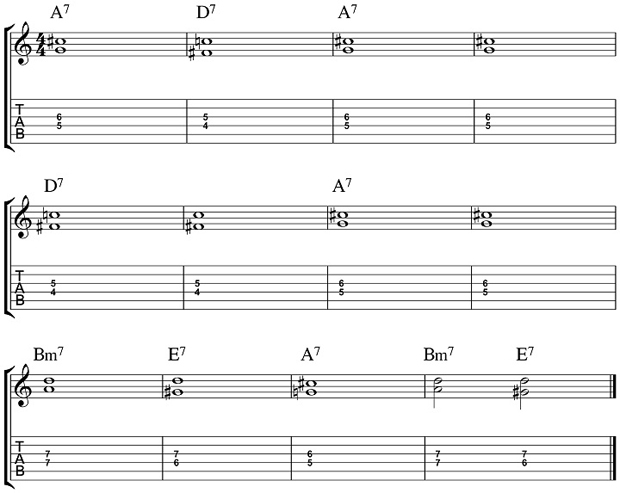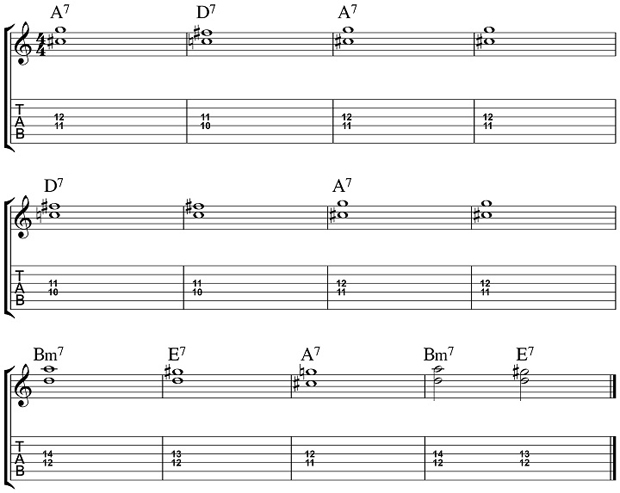Using Two-Note Chords to Play the Blues, Part 1
There are some easy-to-play and effective shapes you can learn in order to quickly outline any tune or progression.
When learning how to play jazz guitar, one of the main items we need to tackle is playing effective, jazzy-sounding chords that properly outline the chord changes all at the same time.
While this may seem like a tall order, there are some easy-to-play and effective shapes we can learn in order to quickly and effectively outline any tune or progression we are jamming on in the woodshed or on the bandstand.
In today’s lesson, we’ll be looking at some of my favorite chord shapes, 3rds and 7ths, as applied to the third and fourth strings of the guitar, and then played over an A blues chord progression. We will be exploring these shapes further in this series of articles, so make sure to check back for more articles that dig further into two-note chords as applied to various jazz-guitar situations.
What Are 3rd and 7th Chords?
Before we learn how to apply these shapes to the third and fourth string set on the guitar, let’s take a look at exactly what 3rd and 7th, two-note shapes are and why they work so well when used in a harmonic situation on the guitar.
The biggest reason these shapes work so well on the guitar? They are small, easy-to-play shapes—but they still outline the underlying chords and progression at the same time.
Here's an example of an A7 chord broken up into an arpeggio and then laid out as a chord, with the 3rd and 7th from each of those shapes extracted in the bar next to the arp and chord.

As you can see, the 3rd and 7th are found in both the A7 arpeggio and chord. You are simply removing the root and 5th of both of those shapes, leaving you with a two-note chord grip on the fretboard.
You may be asking yourself, “But if we remove the root, how can we hear the underlying chord?” That’s a good question and something we should address before moving on.
Even though there is no root in these shapes, you can still hear the underlying chord and progression when applying it to a tune for the following reasons:
01.The 3rd of any chord tells you whether it’s a major- or minor-based chord.
02.The 7th of any chord tells you whether a major based chord is a maj7 or 7th chord—and whether a minor based chord is a m7 or mMaj7 chord.
So, as you can see, even though the root isn’t in the chord, these two notes can still outline the given harmony very effectively when applied to any tune you know or are working on.
There are some situations where you would need another note to fully outline a chord, such as m7b5 or dim7 chord, but for now, we’ll just be looking at m7 and 7th chords over a blues chord progression. We will deal with those shapes in future articles in this series.
3rds and 7ths Over A Blues Chords
Now that you have an idea of what 3rd and 7th, two-note chord shapes are and how they are built, let’s take a look at how you can apply these fun and cool-sounding chords to an A blues chord progression.
Start by playing these chords on your own, with no backing track, so that you can hear how they can sound the harmony of the tune without needing any more accompaniment.
From there, try putting on a backing track and using these chords to comp along over an A blues progression to hear how they sound when applied to the underlying harmony.
Here's an example of applying 3rd and 7th chords on the third and fourth strings beginning with the notes G and C# for the A7 chord in bar one of the form.

And here's an example of applying those same 3rds and 7ths, on the same string set, but this time with C# and G being the starting notes for the A7 chord in bar one of the form.

Though you are only using two notes per chord, when you play through the above examples, you can still hear the harmonic movement and chord progression for the underlying A blues form.
This is one of the reasons two-note chords are so important to learn. They perfectly outline a chord progression and they also are very easy to play on the guitar, freeing up your fingers to add extensions and other colors on top of these shapes as you take them further.
Practicing 3rds and 7ths Over Blues
After sampling the two-note chords in the above examples, here are five exercises you can try in order to take these shapes further in the practice room:
01.Sing the root of each chord in an A blues while playing the 3rds and 7ths from the first example on the guitar.
02.Sing the root of each chord in an A blues while playing the 3rds and 7ths from the second example on the guitar.
03.Comp through an A blues with the shapes from Example 1, varying the rhythms as you move through the changes.
04.Comp through an A blues with the shapes from Example 2, varying the rhythms as you move through the changes.
05.Repeat the above four exercises in 12 keys and at various tempos on the metronome.
There you have it—a brief introduction to using two-note chords to play an A blues on the guitar. Simple, fun to play shapes that are highly effective and sound great when applied to a solo, duo or combo situation.
Do you have a question about these two-note chords? Post your thoughts in the COMMENTS section below.
Matt Warnock is the owner of mattwarnockguitar.com, a free website that provides hundreds of lessons and resources designed to help guitarists of all experience levels meet their practice and performance goals. Matt lives in the UK, where he is a lecturer in Popular Music Performance at the University of Chester and an examiner for the London College of Music (Registry of Guitar Tutors).
Get The Pick Newsletter
All the latest guitar news, interviews, lessons, reviews, deals and more, direct to your inbox!
Matt Warnock is the owner of mattwarnockguitar.com, a free website that provides hundreds of lessons and resources designed to help guitarists of all experience levels meet their practice and performance goals. Matt lives in the UK, where he teaches Skype guitar students all over the world, and is an examiner for the London College of Music (Registry of Guitar Tutors).









![Joe Bonamassa [left] wears a deep blue suit and polka-dotted shirt and plays his green refin Strat; the late Irish blues legend Rory Gallagher [right] screams and inflicts some punishment on his heavily worn number one Stratocaster.](https://cdn.mos.cms.futurecdn.net/cw28h7UBcTVfTLs7p7eiLe.jpg)
